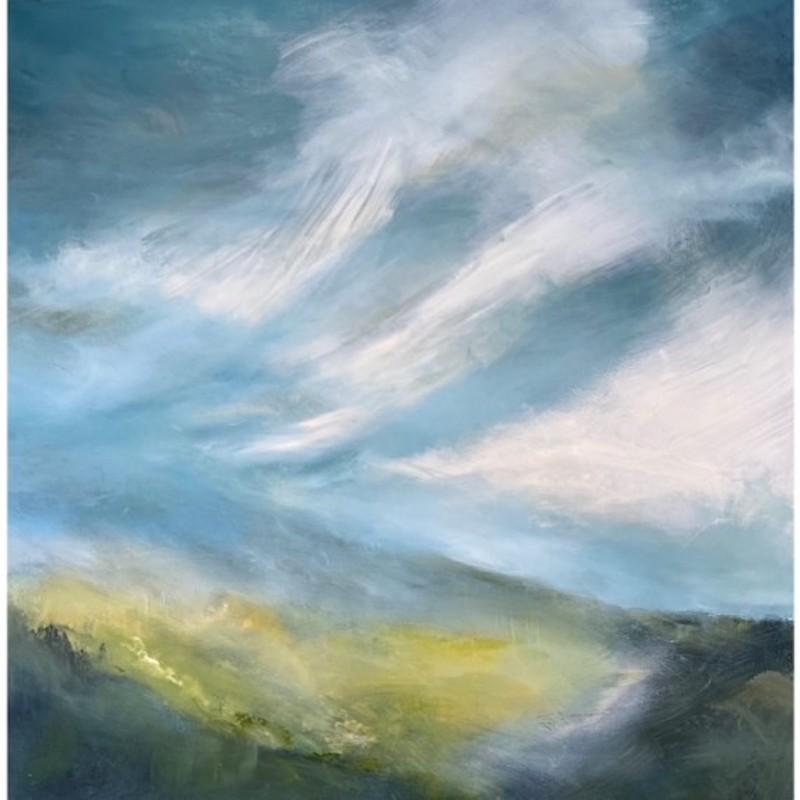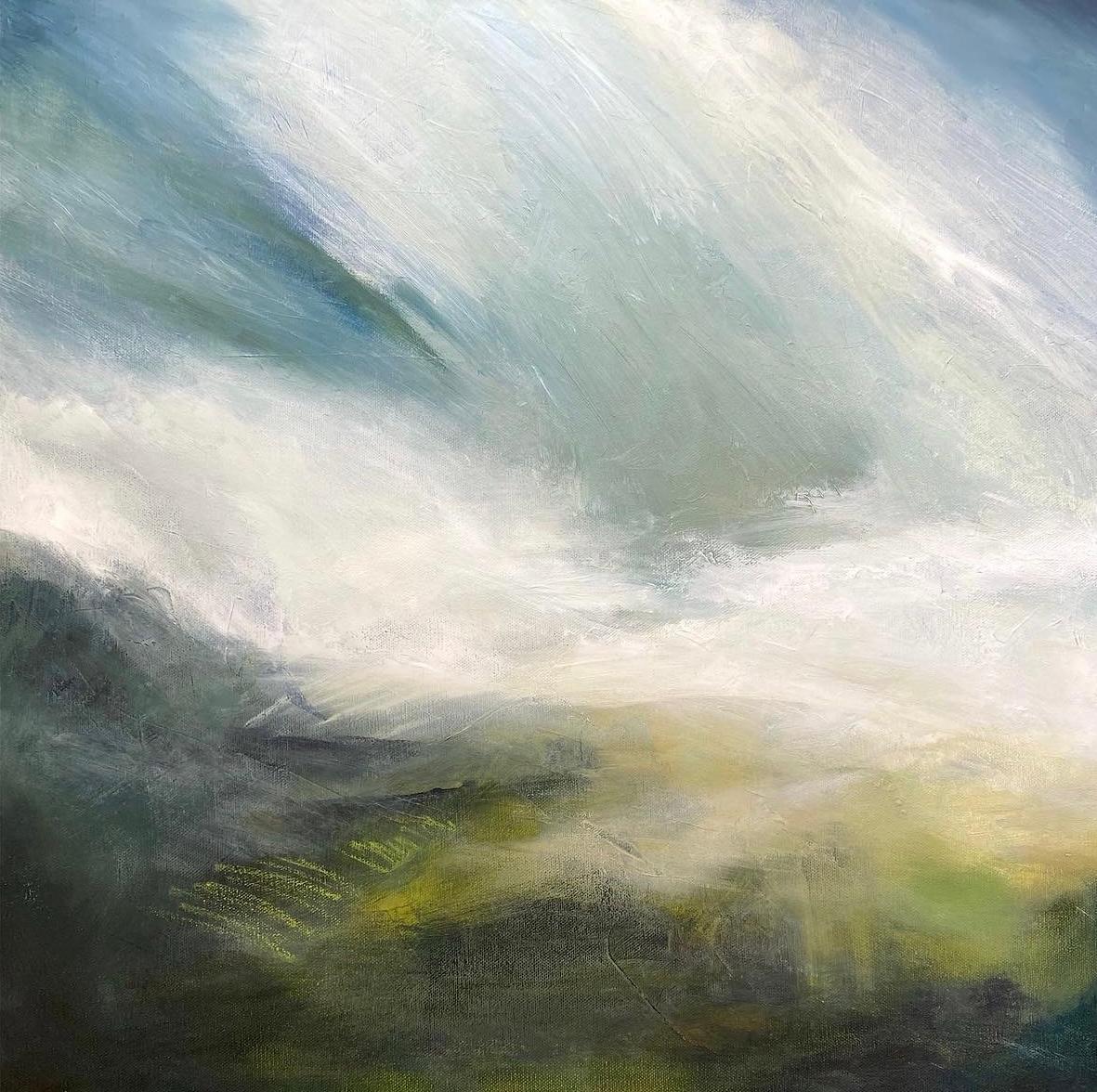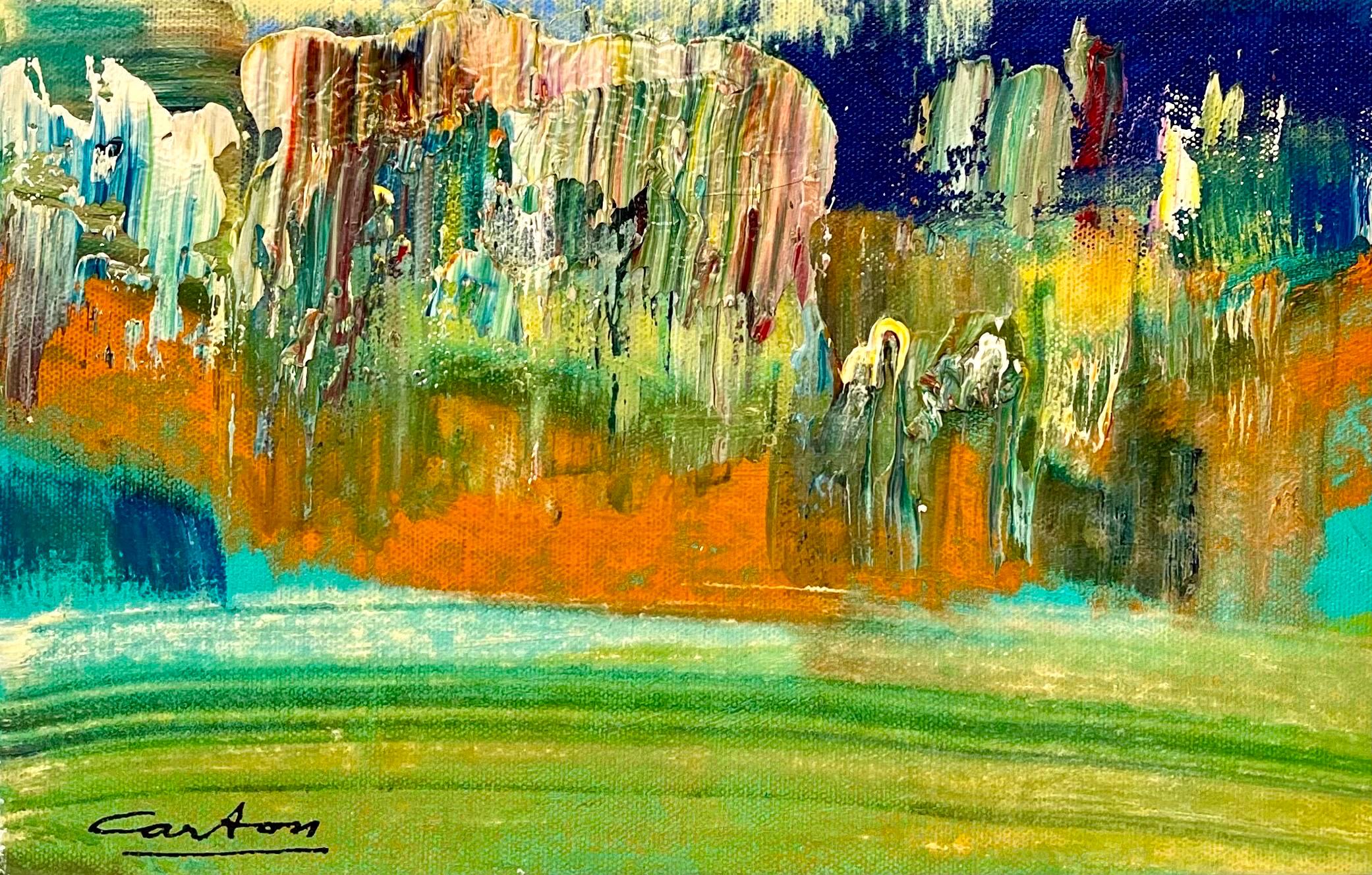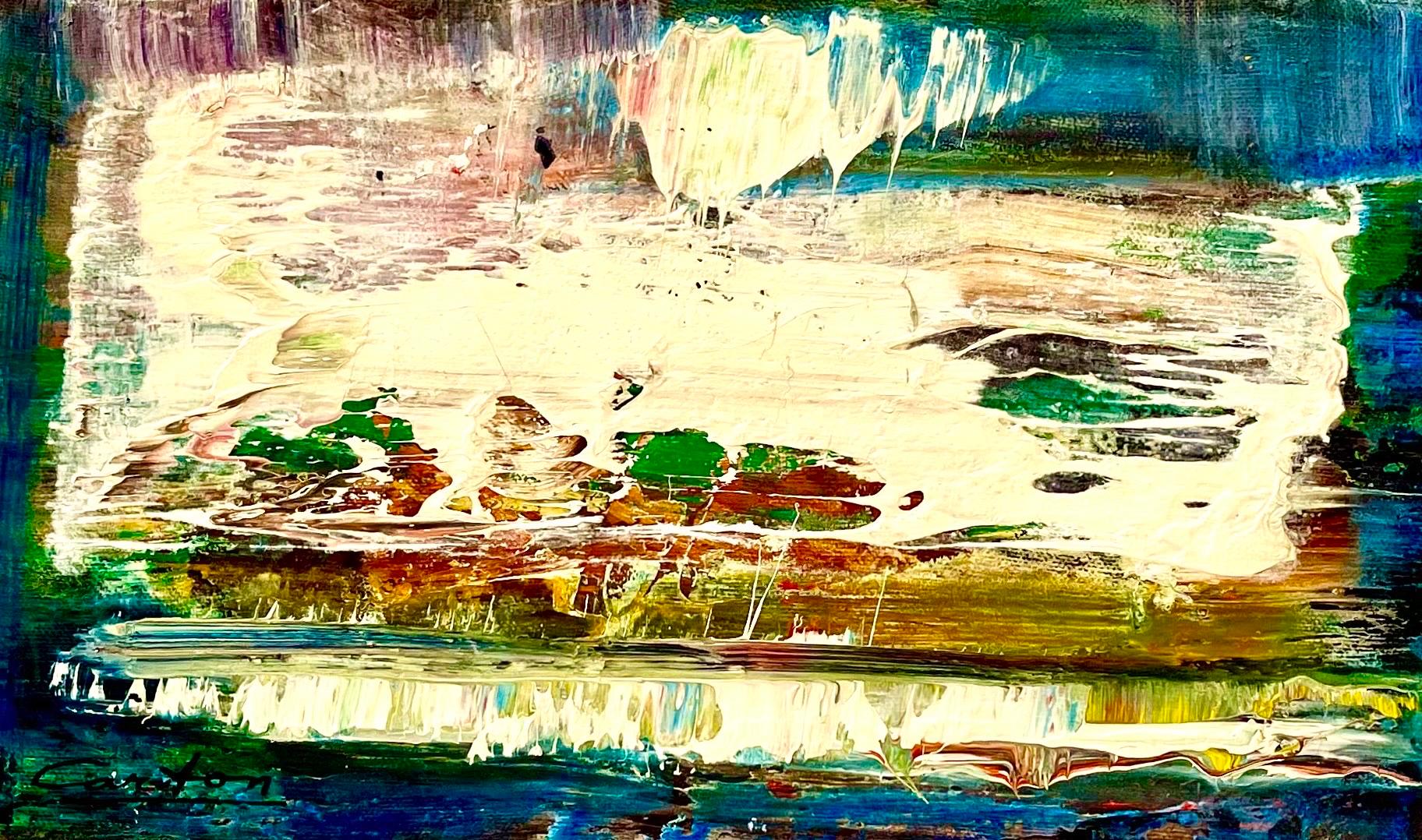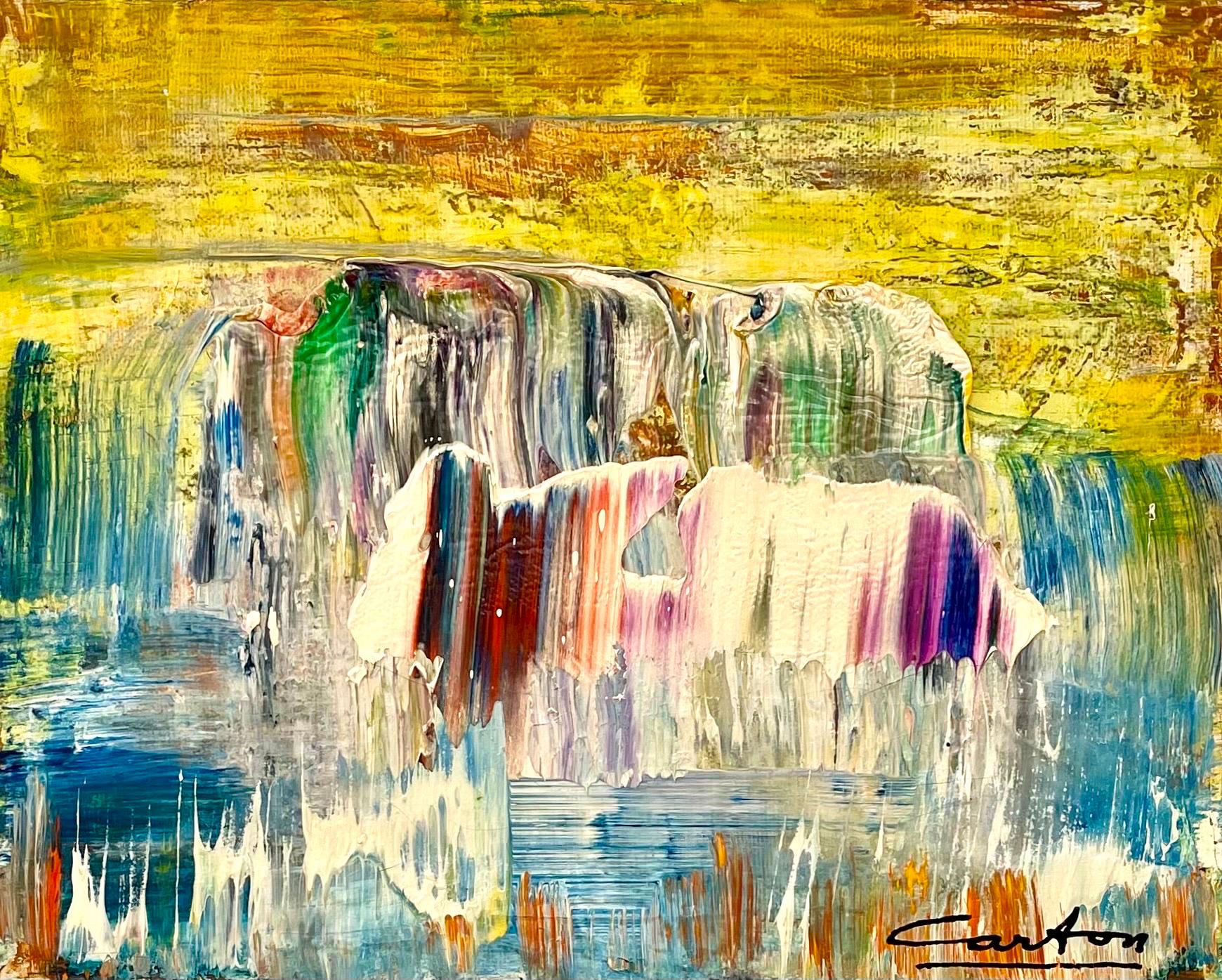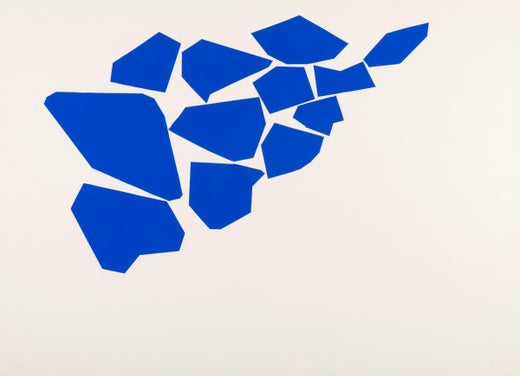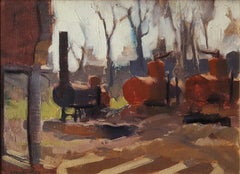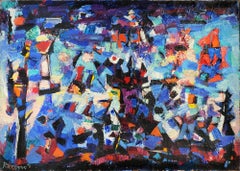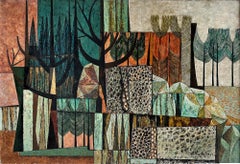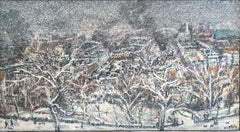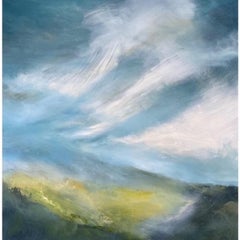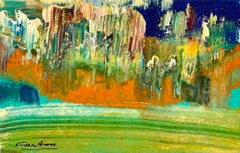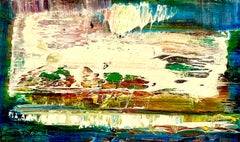Items Similar to Squares - Color Field Painting - like Mondrian
Video Loading
Want more images or videos?
Request additional images or videos from the seller
1 of 25
Robert Goodnough, 1917-2010Squares - Color Field Painting - like MondrianCa. 1950
Ca. 1950
About the Item
Squares is a bridge between Mondrian and the Hard-edge abstraction movement. Clearly, this is a very early work because the artist has not yet found his mature style. The flat squares of uneven proportion, are in a formal but off-axis vertical /horizontal grid structure. Perhaps it's the artists take on a "drunk Mondrian" where the squares stumble to align themselves. Each square shape is different in shape and color and with visible brushstrokes and light impasto. Look carefully at the gray squares. They all have a slightly different hue. The squares are all unique individuals and not a repetition To Goodnough this was his departure from his influencer.
Squares show the influence of his teachers including Hans Hofman, but with a smaller rectilinear vocabulary.
Goodnough was studied with Hans Hofman and his very early work was influenced by Mondrian.
However, Goodnough took it a step further. What makes "Squares" special in the artist oeuvre is that this is the only example we could find of a work like this. Rarity is an important factor in pricing art.
Step Sister of Robert Goodnough. Goodnough gave it to her. An early example of geometric abstraction by one of the last of the original generation of the New York School. It was done at the same time the Pollack, Kline, Still and Rothko were doing their groundbreaking work. Robert Goodnough has fallen in the cracks of art history and to some extent has been passed over. He participated in the Ninth Street Show. Along with the Armory Show, it's arguably one of the seminal moments in American art. Nonetheless, this is quite an important painting in the history of abstract expressionism. Work has not been cleaned and is in the original pieced-together hand made frame that is nailed into the stretchers. We acquired the work from Goodnough's sister in law from upstate New York
Hand-signed by artist, sticker label, Signed lightly in pencil lower right. Inscribed, Titled on verso -
- Creator:Robert Goodnough, 1917-2010 (1917 - 2010, American)
- Creation Year:Ca. 1950
- Dimensions:Height: 39.5 in (100.33 cm)Width: 22.5 in (57.15 cm)
- Medium:
- Movement & Style:
- Period:
- Condition:recently cleaned and restored -.
- Gallery Location:Miami, FL
- Reference Number:1stDibs: LU38536549912
Robert Goodnough, 1917-2010
Though he is often grouped with the Abstract Expressionists, Robert Goodnough’s style incorporates representational forms that work against the abstract dogmas set by this movement. In this painting, Goodnough’s use of abstract shapes and primary colors are simple in concept, but complicated in their overlapping and varying sizes. This work has been exhibited at the Wittenborn Gallery in 1950, The Whitney Museum of American Art in 1957, the Museum of Modern Art in 1969, the National Academy in 2007, and Bowdoin College Museum of Art in 2009.
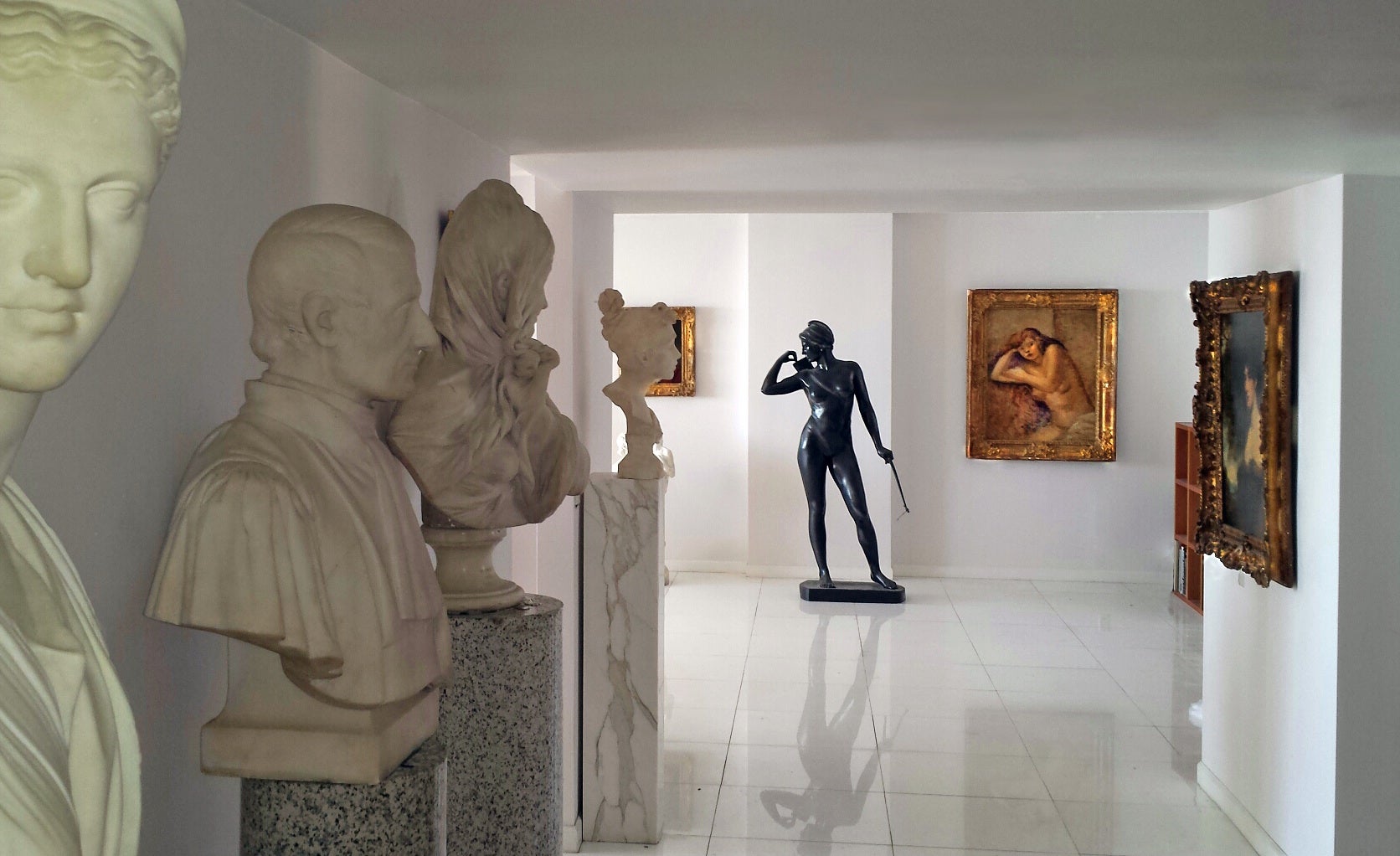
About the Seller
4.9
Vetted Professional Seller
Every seller passes strict standards for authenticity and reliability
Established in 2005
1stDibs seller since 2016
111 sales on 1stDibs
Typical response time: 1 hour
- ShippingRetrieving quote...Shipping from: Miami, FL
- Return Policy
Authenticity Guarantee
In the unlikely event there’s an issue with an item’s authenticity, contact us within 1 year for a full refund. DetailsMoney-Back Guarantee
If your item is not as described, is damaged in transit, or does not arrive, contact us within 7 days for a full refund. Details24-Hour Cancellation
You have a 24-hour grace period in which to reconsider your purchase, with no questions asked.Vetted Professional Sellers
Our world-class sellers must adhere to strict standards for service and quality, maintaining the integrity of our listings.Price-Match Guarantee
If you find that a seller listed the same item for a lower price elsewhere, we’ll match it.Trusted Global Delivery
Our best-in-class carrier network provides specialized shipping options worldwide, including custom delivery.More From This Seller
View AllIndustrial Landscape
By George Luks
Located in Miami, FL
Quick and confident brush strokes describe the gritty forms of perhaps steam engines or railroad yards. Luks bravura style of putting paint to canvas anticipates action painting of ...
Category
1930s Abstract Expressionist Landscape Paintings
Materials
Oil
$14,800 Sale Price
20% Off
Storm Composition #3
By Abraham Rattner
Located in Miami, FL
An early example of Abstract Expressionism executed in 1955 during the movement's heyday and it's period of peak inventiveness. However, this work is still rooted in representation. The dark area the runs along the base of the picture is the ground and to the left, right and center there are black structures that represent trees. The work is very tactile and is composed of globs of paint that grow out from the surface and form a thick impasto. Rich vibrant saturated blues, reds and oranges create optical drama. The work look better in person. frame: 29 x 39 1/2 inches , Provenance: Kennedy Galleries
The Currier Gallery of Art...
Category
1950s Abstract Expressionist Abstract Paintings
Materials
Oil
Landscape Abstraction - Mid-Century - Twenty Paintings in One
Located in Miami, FL
At the height of Abstraction Expressionism, overlooked Academic Artist John Atherton created a wonderfully complex painting that embodies many of the characteristics of what was going on in Mid-Century American Art. The work is simultaneously abstract as it is representational. Like a Bento Box, it's divided into sections by dividers. On close inspection, each section stands on it's own as a beautiful mini-painting yet coalesces as part of the whole. From a distance, it is eye-pleasing, but as the view gets closer and closer, new structures and details gloriously reveal themselves. This is an important painting and not unlike the work of Joaquín Torres-García. It was done in the last year of the artist's life. Signed lower right. Canvas is relined. Framed size: 30 x 41.25. The work is best viewed with top gallery lights to bring out color.
Color will look different under different lighting conditions. Atherton exhibited at the famous Julien Levy Gallery in New York and his fine art is mainly associated with Magic Realism. He participated in the seminal 1943 Museum of Modern Art exhibition, American Realists and Magic Realists. The Museum of Modern Art has 4 Atherton paintings in its collection. As an Illustrator, Atherton did covers for the Saturday Evening Post, Fortune and Holiday Magazine...
Category
1950s Abstract Expressionist Abstract Paintings
Materials
Canvas, Oil
Snowstorm, Morningside Heights, New York City - Monochromatic
Located in Miami, FL
Eugene Camille Fitsch
Am./Fr., 1892-1972 - Signed lower right. Framed dimensions 20 3/4" x 34 7/8" framed
Provenance: Studio of the Artist to Private Collection Boston, Massachuse...
Category
1940s Abstract Expressionist Landscape Paintings
Materials
Casein
Thought Provoking Rock Quarry - Mid Century Abstract
Located in Miami, FL
This meticulously planned, designed, and executed work depicts an ultra-wide angle view of a rock quarry/mine. The viewer looks down at close-up-stylized rock formations and then out at a horizon line with rust-colored mine trestles. Atherton hints at perspective with a broken white line that is wider in the foreground and tapers to a hairline as it recedes to the background. The work was done in 1951 at the height of America's most important art movement: Abstract Expressionism. John Atherton absorbs its influences but retains elements of representation. Atherton was an in-demand commercial artist who worked for most blue-chip clients. It is possible that this was an editorial assignment for Fortune Magazine. At the same time, Atherton was also a fine artist and the work could be an expression of pure creative pursuits. The work looks better in person and one can look at it for hours and not get bored. Look carefully and you may discover a deeper meaning in this painting of precisely arranged rocks. Signed lower right.
Brooklyn Museum of Art, New York, sold to benefit the acquisitions program
____________________
From Wikipedia, the free encyclopedia
John Carlton Atherton (January 7, 1900 - September 16, 1952) was an American painter and magazine illustrator, writer and designer. His works form part of numerous collections, including the Museum of Modern Art,[1] Whitney Museum of American Art and the Smithsonian American Art Museum.[2][3][4]
Early Years
He was the son of James Chester Atherton (1868-1928) and Carrie B. Martin (1871-1909). He was born in Brainerd, Minnesota.[5] His father was Canadian born. His parents relocated from Minnesota to Washington State, with his maternal grandparents whilst he was still an infant. He attended high school in Spokane, Washington.
Career
During his early years he never displayed an aptitude for art; rather, his first love being nature and the activities he relished there, mainly fishing and hunting. He enlisted in 1917, serving briefly in the U.S. Navy for a year during World War I. At the end of the war, determined to get an education he worked various part-time jobs, as a sign painter and playing a banjo in a dance band to pay his enrolment fee at the College of the Pacific and The California School of Fine Arts (now the San Francisco Art Institute). Once there, he also worked in the surrounding studios developing his oil painting techniques.
A first prize award of $500 at the annual exhibition of the Bohemian Club in 1929, financed his one way trip to New York City, which helped to launch his career as an artist.[6]
Atherton had aspired to be a fine artist, however his first paid jobs were for commercial art firms designing advertisements for corporations such as General Motors, Shell Oil, Container Corporation of America, and Dole. However, by 1936, encouraged primarily by friends, such as Alexander Brook, an acclaimed New York realist painter, he returned to the fine arts.
Atherton continued to accept numerous commissions for magazine illustrations; such as Fortune magazine, and over the years he would paint more than forty covers for The Saturday Evening Post starting with his December 1942 design, “Patient Dog.” This picture is reminiscent of his friend Norman Rockwell ‘Americana style’ and captures a poignant moment of nostalgia, where a loyal dog looks toward a wall of hunting equipment and a framed picture of his owner in military uniform.
Selected One person Exhibitions
Atherton accomplished his first one-man show in Manhattan in 1936. His Painting, “The Black Horse” won the $3000 fourth prize from among a pool of 14,000 entries. This painting forms part of the Metropolitan Museum of Art collection in New York.[7]
Atherton achieved recognition in New York City and elsewhere during the 1930s. Having exhibited at the Julien Levy Gallery in New York,[8] his paintings began to be collected by museums; including the Museum of Modern Art[9] and the Metropolitan Museum of Art.
His reputation increased with his art deco stone lithograph poster for the 1939 New York World's Fair. In 1941, his design won first place in the Museum of Modern Arts “National Defense Poster Competition”.
Selected Public Collections
Fleming Museum of Art, Burlington, Vermont
Albright-Knox Art Gallery,[10] Buffalo, NY
Art Institute of Chicago,[11] Chicago
Wadsworth Atheneum,[12] Hartford, CT
Brooklyn Museum of Art, New York
Metropolitan Museum of Art, New York
The Museum of Modern Art,[13] New York
Whitney Museum of American Art,[14] New York
Pennsylvania Academy of the Fine Arts,[15] Philadelphia
De Young Museum,[16] San Francisco
Smithsonian American Art Museum,[17] Washington DC
Butler Institute of American Art[18] Youngstown, OH
The Famous Artists School
Founded in 1948 in Westport, Connecticut, U.S.A. The idea was conceived by members of the New York Society of Illustrators (SOI), but due to the Society's legal status, could not be operated by it. SOI member Albert Dorne led the initiative to set up a separate entity, and recruited the support of Norman Rockwell, who was also an SOI member. For the founding faculty, Dorne recruited Atherton, as well as accomplished artists such as Austin Briggs, Stevan Dohanos, Robert Fawcett, Peter Helck, Fred Ludekens, Al Parker, Norman Rockwell, Ben Stahl, Harold von Schmidt and Jon Whitcomb.[19]
He collaborated with Jon Whitcomb with the book “How I Make a Picture: Lesson 1-9, Parts 1”.[20][21]
Society of Illustrators
Atherton as an active member from his arrival in New York. The society have owned many of his works. Ex-collection includes:
Rocking Horse (ca. 1949) [22]
Atherton, as his peers had many of his works framed by Henry Heydenryk Jr.[23]
Personal
On November 2, 1926, he married Polly “Maxine” Breese (1903-1997).[24][25] They had one daughter, Mary Atherton, born in 1932.
Atherton's often chose industrial landscapes, however found himself spending considerable time in Westport, Connecticut, with an active artistic community, and it became home for him, and his family. He then moved to Arlington, Vermont.[26]
Norman Rockwell enlisted Atherton in what was to be the only collaborative painting in his career.[27]
He was part of a group of artists including a Norman Rockwell, Mead Schaeffer and George Hughes who established residences in Arlington.[28] Atherton and Mead Schaeffer were avid fly fishermen and they carefully chose the location for the group,[29] conveniently located near the legendary Battenkill River.
In his free time, Atherton continued to enjoy fly-fishing.[30] He brought his artistic talent into the field of fishing,[31] when he wrote and illustrated the fishing classic, “The Fly and The Fish”.[32]
He died in New Brunswick, Canada in 1952,[33] at the age of 52 in a drowning accident while fly-fishing.[34]
Legacy
The Western Connecticut State University holds an extensive archive on this artist.[35]
His wife, Maxine also published a memoir “The Fly Fisher and the River” [36] She married Watson Wyckoff in 1960.
Ancestry
He is a direct descendant of James Atherton,[37][38] one of the First Settlers of New England; who arrived in Dorchester, Massachusetts in the 1630s.
His direct ancestor, Benjamin Atherton was from Colonial Massachusetts...
Category
1950s Abstract Expressionist Abstract Paintings
Materials
Mixed Media, Gouache, Board
City Scape Abstract Expressionist Composition -Jackson Pollack Friend
By Joseph Meert
Located in Miami, FL
The fame, notoriety, and monetary value of an artist's work in today's market are not based on one's talent and vision. Factors such as marketing and media momentum play a defining r...
Category
1940s Abstract Expressionist Abstract Paintings
Materials
Gouache
You May Also Like
Bluster By Elaine Fox
Located in Deddington, GB
original
Oil on Cradled Panel
Image size: H:30 cm x W:30 cm
Complete Size of Unframed Work: H:30 cm x W:30 cm x D:2cm
Sold Unframed
Please note that insitu images are purely an ...
Category
2010s Abstract Expressionist Landscape Paintings
Materials
Oil
Where the Light Falls, Elaine Fox, Contemporary Landscape Painting
Located in Deddington, GB
Where the Light Falls [2022]
Signed by the artist
oil and oil pastel on canvas
Image size: H:50 cm x W:50 cm
Complete Size of Unframed Work: H:50 cm x W:50 cm x D:4cm
Frame Size: H:54 cm x W:54 cm x D:5.5cm
Please note that insitu images are purely an indication of how a piece may look
A painting completed in the studio after a visit to the Outer Hebrides, the unpredictable weather patterns and light played an important role in creating this piece. The weather on Skye is forever changing and the dramatic and mystical landscapes are what inspires me to try to capture the feeling of energy and atmosphere. This painting is framed in a white tray frame to fit with any decor.
laine Fox - Artist - Painter Elaine Fox...
Category
21st Century and Contemporary Abstract Expressionist Landscape Paintings
Materials
Canvas, Oil Pastel, Oil
American Vivid Abstract Expressionist Art Oil Painting Norman Carton, WPA Artist
By Norman Carton
Located in Surfside, FL
Norman Carton (1908 – 1980) was an American artist and educator known for abstract expressionist art. He was born in the Ukraine region of Imperial Russia and moved to the United States in 1922 where he spent most of his adult life.
A classically trained portrait and landscape artist, Carton also worked as a drafter, newspaper illustrator, muralist, theater set designer, photographer, and fabric designer and spent most of his mature life as an art educator. Carton showed in and continues to be shown in many solo and group exhibitions. His work is included in numerous museums and private collections throughout the world.
Norman Carton was born in the Dnieper Ukraine territory of the Russian Empire in 1908. Escaping the turbulence of civil war massacres, he settled in Philadelphia in 1922 after years of constant flight. While attending the Pennsylvania Museum School of Industrial Art, Carton worked as a newspaper artist for the Philadelphia Record from 1928 to 1930 in the company of other illustrator/artists who had founded the Ashcan School, the beginnings of modern American art. From 1930 to 1935, he studied at the Pennsylvania Academy of Fine Arts under Henry McCarter, who was a pupil of Toulouse-Lautrec, Puvis de Chavanne, and Thomas Eakins. Arthur Carles, especially with his sense of color, and the architect John Harbison also provided tutelage and inspiration. Following his time at the Pennsylvania Academy of Fine Arts, Carton studied at the Barnes Foundation from 1935 to 1936 where he was influenced by an intellectual climate led by visiting lecturers John Dewey and Bertrand Russell as well as daily access to Albert C. Barnes and his art collection.
Carton was awarded the Cresson Traveling Scholarship in 1934 which allowed him to travel through Europe and study in Paris. There he expanded his artistic horizons with influences stemming from Henri Matisse, Pablo Picasso, Chaim Soutine, and Wassily Kandinsky. While at the Pennsylvania Academy of Fine Arts, Carton was also awarded the Toppan Prize for figure painting as well as the Thouron Composition Prize. He received numerous commissions as a portrait artist, social realist, sculptor, and theatrical stage designer as well as academic scholarships. During this time, Carton worked as a scenery designer at Sparks Scenic Studios, a drafter at the Philadelphia Enameling Works, and a fine art lithographer.
From 1939 to 1942, the Works Progress Administration (WPA) Federal Art Project employed Carton as a muralist and easel artist. He collaborated with architect George Howe. The WPA commissioned Carton to paint major murals at the Helen Fleischer Vocational School for Girls in Philadelphia, the Officers’ Club at Camp Meade Army Base in Maryland, and in the city of Hidalgo, Mexico. Throughout the 1940s, Carton exhibited and won prizes for his semi-abstract Expressionist and Surrealist paintings. He socialized with and was inspired by Émile Gauguin and Fernand Leger. During World War II, Carton was a naval structural designer and draftsman at the Cramps...
Category
Mid-20th Century Abstract Expressionist Landscape Paintings
Materials
Canvas, Oil
American Vivid Abstract Expressionist Art Oil Painting Norman Carton, WPA Artist
By Norman Carton
Located in Surfside, FL
Norman Carton (1908 – 1980) was an American artist and educator known for abstract expressionist art. He was born in the Ukraine region of Imperial Russia and moved to the United States in 1922 where he spent most of his adult life.
A classically trained portrait and landscape artist, Carton also worked as a drafter, newspaper illustrator, muralist, theater set designer, photographer, and fabric designer and spent most of his mature life as an art educator. Carton showed in and continues to be shown in many solo and group exhibitions. His work is included in numerous museums and private collections throughout the world.
Norman Carton was born in the Dnieper Ukraine territory of the Russian Empire in 1908. Escaping the turbulence of civil war massacres, he settled in Philadelphia in 1922 after years of constant flight. While attending the Pennsylvania Museum School of Industrial Art, Carton worked as a newspaper artist for the Philadelphia Record from 1928 to 1930 in the company of other illustrator/artists who had founded the Ashcan School, the beginnings of modern American art. From 1930 to 1935, he studied at the Pennsylvania Academy of Fine Arts under Henry McCarter, who was a pupil of Toulouse-Lautrec, Puvis de Chavanne, and Thomas Eakins. Arthur Carles, especially with his sense of color, and the architect John Harbison also provided tutelage and inspiration. Following his time at the Pennsylvania Academy of Fine Arts, Carton studied at the Barnes Foundation from 1935 to 1936 where he was influenced by an intellectual climate led by visiting lecturers John Dewey and Bertrand Russell as well as daily access to Albert C. Barnes and his art collection.
Carton was awarded the Cresson Traveling Scholarship in 1934 which allowed him to travel through Europe and study in Paris. There he expanded his artistic horizons with influences stemming from Henri Matisse, Pablo Picasso, Chaim Soutine, and Wassily Kandinsky. While at the Pennsylvania Academy of Fine Arts, Carton was also awarded the Toppan Prize for figure painting as well as the Thouron Composition Prize. He received numerous commissions as a portrait artist, social realist, sculptor, and theatrical stage designer as well as academic scholarships. During this time, Carton worked as a scenery designer at Sparks Scenic Studios, a drafter at the Philadelphia Enameling Works, and a fine art lithographer.
From 1939 to 1942, the Works Progress Administration (WPA) Federal Art Project employed Carton as a muralist and easel artist. He collaborated with architect George Howe. The WPA commissioned Carton to paint major murals at the Helen Fleischer Vocational School for Girls in Philadelphia, the Officers’ Club at Camp Meade Army Base in Maryland, and in the city of Hidalgo, Mexico. Throughout the 1940s, Carton exhibited and won prizes for his semi-abstract Expressionist and Surrealist paintings. He socialized with and was inspired by Émile Gauguin and Fernand Leger. During World War II, Carton was a naval structural designer and draftsman at the Cramps...
Category
Mid-20th Century Abstract Expressionist Landscape Paintings
Materials
Canvas, Oil
American Vivid Abstract Expressionist Art Oil Painting Norman Carton, WPA Artist
By Norman Carton
Located in Surfside, FL
Norman Carton (1908 – 1980) was an American artist and educator known for abstract expressionist art. He was born in the Ukraine region of Imperial Russi...
Category
Mid-20th Century Abstract Expressionist Landscape Paintings
Materials
Canvas, Oil
American Vivid Abstract Expressionist Art Oil Painting Norman Carton, WPA Artist
By Norman Carton
Located in Surfside, FL
Norman Carton (1908 – 1980) was an American artist and educator known for abstract expressionist art. He was born in the Ukraine region of Imperial Russia and moved to the United States in 1922 where he spent most of his adult life.
A classically trained portrait and landscape artist, Carton also worked as a drafter, newspaper illustrator, muralist, theater set designer, photographer, and fabric designer and spent most of his mature life as an art educator. Carton showed in and continues to be shown in many solo and group exhibitions. His work is included in numerous museums and private collections throughout the world.
Norman Carton was born in the Dnieper Ukraine territory of the Russian Empire in 1908. Escaping the turbulence of civil war massacres, he settled in Philadelphia in 1922 after years of constant flight. While attending the Pennsylvania Museum School of Industrial Art, Carton worked as a newspaper artist for the Philadelphia Record from 1928 to 1930 in the company of other illustrator/artists who had founded the Ashcan School, the beginnings of modern American art. From 1930 to 1935, he studied at the Pennsylvania Academy of Fine Arts under Henry McCarter, who was a pupil of Toulouse-Lautrec, Puvis de Chavanne, and Thomas Eakins. Arthur Carles, especially with his sense of color, and the architect John Harbison also provided tutelage and inspiration. Following his time at the Pennsylvania Academy of Fine Arts, Carton studied at the Barnes Foundation from 1935 to 1936 where he was influenced by an intellectual climate led by visiting lecturers John Dewey and Bertrand Russell as well as daily access to Albert C. Barnes and his art collection.
Carton was awarded the Cresson Traveling Scholarship in 1934 which allowed him to travel through Europe and study in Paris. There he expanded his artistic horizons with influences stemming from Henri Matisse, Pablo Picasso, Chaim Soutine, and Wassily Kandinsky. While at the Pennsylvania Academy of Fine Arts, Carton was also awarded the Toppan Prize for figure painting as well as the Thouron Composition Prize. He received numerous commissions as a portrait artist, social realist, sculptor, and theatrical stage designer as well as academic scholarships. During this time, Carton worked as a scenery designer at Sparks Scenic Studios, a drafter at the Philadelphia Enameling Works, and a fine art lithographer.
From 1939 to 1942, the Works Progress Administration (WPA) Federal Art Project employed Carton as a muralist and easel artist. He collaborated with architect George Howe. The WPA commissioned Carton to paint major murals at the Helen Fleischer Vocational School for Girls in Philadelphia, the Officers’ Club at Camp Meade Army Base in Maryland, and in the city of Hidalgo, Mexico. Throughout the 1940s, Carton exhibited and won prizes for his semi-abstract Expressionist and Surrealist paintings. He socialized with and was inspired by Émile Gauguin and Fernand Leger. During World War II, Carton was a naval structural designer and draftsman at the Cramps Shipbuilding Corporation in Camden, New Jersey. Here, he created non-objective sculpture with metal. After the war, Carton co-founded a fabric design plant in Philadelphia. He produced hand-printed fabrics for interiors and fashion that were featured in Harper’s Bazaar, Vogue and Women’s Wear Daily. Original fabric designs were commissioned by notable clients including Lord & Taylor, Gimbels, and Nina Ricci. Some of these designs are at the Metropolitan Museum of Art. Carton traded his partnership in the fabric design company in 1949 to focus full-time on painting. Carton had his first solo exhibition in 1949 at the Philadelphia Art Alliance. This show was followed closely by solo exhibitions at the Laurel Gallery (New York City) and Dubin Gallery (Philadelphia). At this time, his exhibited work was Abstract impressionism. In addition to painting, he taught classes at the Philadelphia Museum of Art and was the Founder and first President of the Philadelphia chapter of Artist’s Equity Association. The Philadelphia Museum of Art and the organization of the National Museums of France commissioned Carton to travel to Europe, mainly France, in 1950 for a color photography study of continental masterpieces. He was granted access to study the restoration of the Mona Lisa and was one of the very few to be given permission to remove the painting from its frame. During his three year stay in Paris, he had solo exhibits at La Sorbonne and Gallery Rene Breteau and was in 15 group shows in Paris salons including Les Sur Independants, Salon d’Automne, and Realities Nouvelles. He also exhibited at the Musee d’Art Juif where he won the Prix d’Art. The Cercle Paul Valery twice sponsored Carton to present lectures at the Sorbonne. He conducted seminars at the Louvre for the Cercle Esthetique Internationale and taught classes in and directed stage and costume design for the Theatre de Recherche at the Paris Opera. Among his Paris artist colleagues were Chana Orloff, Earl Kerkam, Sam Francis, Claire Falkenstein, Lawrence...
Category
Mid-20th Century Abstract Expressionist Landscape Paintings
Materials
Canvas, Oil
Recently Viewed
View AllMore Ways To Browse
Small Square Art
Mondrian Signed
Drunk Art
Vintage Beauty Poster
1964 Books
Black White Winter Photography
Graphic Design Exhibition Poster
Portrait Oil Young Man
Wood Sculpture Dancers
Cartier Paper
Framed Intaglios
Hermes Printed Bag
Home Movies
Lithograph Erotic
Portrait Of Gentleman
Posters 1962
Rauschenberg Print
Retro Vintage Prints
